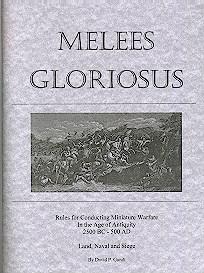
Melees Gloriosus

- the naval game
Back to MELEES GLORIOSUS - DETAILED DESCRIPTION
The naval module of Melees Gloriosus is included in order not to ignore "a major aspect of warfare in the ancient world." The 17-page section includes rules, historical background, some suggestions for fleets in different periods, and a synopsis of strategy and tactics. The naval rules are designed to be "simple yet somewhat detailed."
Ships and Galleys
Melees Gloriosus recognizes the following classifications of ships:
- freighters
- transports
- early galleys/river barges (before 900 B.C.)
- triakonters/pentekonters
- war galleys (from triremes to 11's)
- patrol, pursuit, and dispatch vessels
- rivercraft and harborcraft
Each ship class is assigned a point cost, allowing players to design balanced scenarios by using equal point totals. In addition, ships are given training and morale ratings for the officers, crew, and any marines onboard. A ship's hull strength (hit points) is determined by its class.
Players also determine the number of marines (soldiers) per ship. The maximum allowed is determined by the class of the vessel (up to 32 soldiers for a 10/11 class war galley). Class also limits the sizes of artillery that a ship may carry.
As per the land game, each player must designate one ship as his "personal" vessel.
Sequence of Play
The game is played in the following steps:
- Movement
- ship movement
- troop movement
- Missile Fire
- artillery fire
- other missile fire
- Miscellaneous Actions (grapnels, boarding)
- Melee
- Morale
Movement and Ramming
Based on their class, ships have both a movement rating (in inches) and a rating for the number of 45° turns allowed per movement phase. In addition, the ships have different scores depending on if they are operating under oars, under sail, or under both oars and sails (certain ships only). Ships move faster when under sail, but must move every turn, and are not allowed to enter combat. The game uses a simplified system whereby ships with sails move at the same speed always, and there are no rules for wind conditions.
Head-on collisions between vessels are not allowed. Instead, a dieroll determines which direction the ships turn to avoid collision, and separate dierolls determine if either ship "shears off" the oars of the other.
If one ship's ram strikes another ship, a score is determined by comparing the two ship's classes, modified by the rating of the ramming vessel's crew. Three six-sided dice are then rolled and compared to the score, to see if a hit has occurred.
If a hit occurs, the dice are rolled again, modified by the rating of the crew, and compared to the angle of attack to determine how many hits are inflicted. A single ram can cause 1-3 damage points, while ships have between 3 and 8 hull strength points. A ship that receives hits equal to its hull strength will begin to sink, with surplus hits making it sink faster.
After damage is determined, one more roll (two dice) is made. The result is compared against the angle of attack and the crew rating to see if a "unique event" happens. If so, the dice are rolled again and the Unique Event table is consulted. The possible results are loss of the ram, or discovering that the ram is lodged in the target vessel.
| Example: Let's say that a Trireme collides ram-first with a Quinquereme.
To see if a ram occurs, the vessel classes are compared to arrive at a score. In this
case, a Trireme vs. Quinquereme gives a score of "13+". The crew of the Trireme is
Veteran, giving a bonus of +1.
The Trireme player now rolls three dice, adding +1 to the result, hoping to meet or beat the target of "13." He rolls a "15," modified to a "16," which succeeds. Next, he determines the amount of damage caused. The ram came from the side of the target ship. Rolling three dice, he obtains a score of "16," modified to "17," which compared to the angle of attack results in the maximum possible damage (3 hits). However, the Quinquereme has 6 hull strength points, so it is in no danger of sinking unless rammed again. Finally, the Trireme player must guard against Unique Events. He rolls two dice and gets a "7," which compared versus a Side ram and a Veteran crew, means nothing happens. (He needed to roll snake eyes - "2" - to have something bad happen.) |
At the end of the Movement phase, troops may move. All ships are considered to have two "areas" - fore and aft. Troops can move one area per turn, but can only board another ship during the Miscellaneous Action phase.
Combat and Morale
Missile and melee combat are resolved using the same rules systems as in the land game.
Missile combat is identical to the main game, except that artillery has shorter ranges (due to being bow-type rather than torsion-type), and a new modifier table is used. Rules are added for the harpax (an artillery-fired grapnel used by the Romans), for flaming arrows and fire, and for targeting individual officers.
The Morale rules are the same as in the land game, except that Morale applies to ships rather than units, and a ship's Morale score begins to decline after only 20% of hits are lost (versus 30% in the land game). A different table of morale modifiers is used, and the results of a failed Morale check vary depending on whether the ship has been boarded or not.